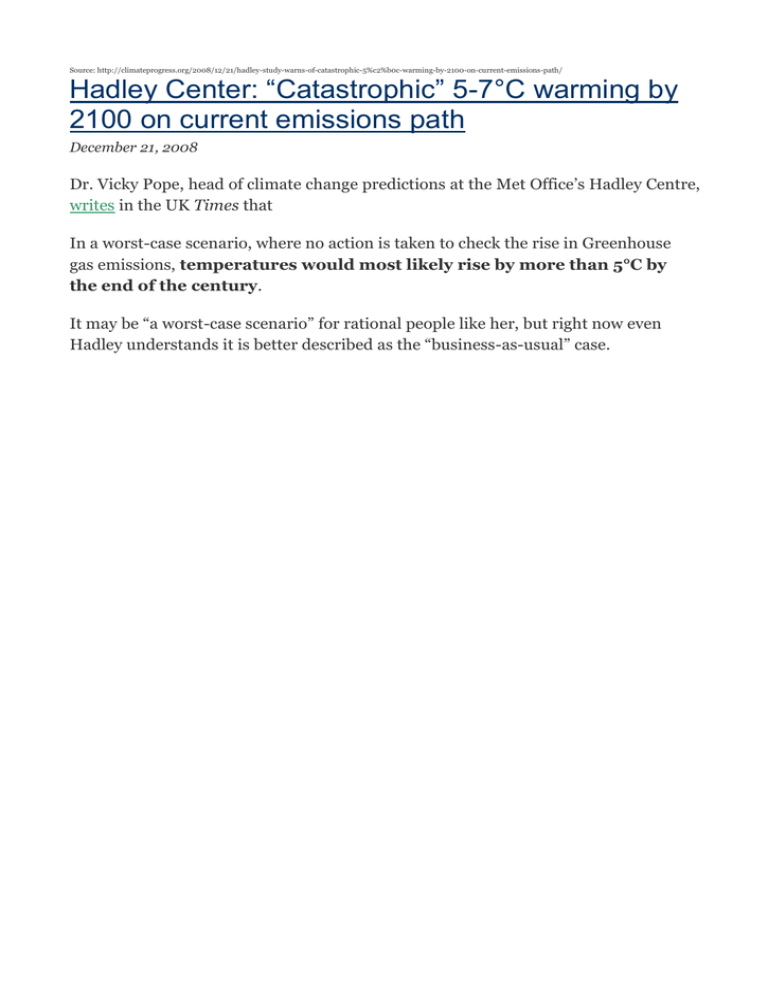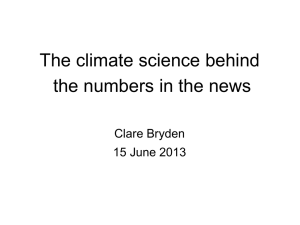Hadley Center: “Catastrophic” 5-7°C warming by 2100 on current emissions path
advertisement

Source: http://climateprogress.org/2008/12/21/hadley-study-warns-of-catastrophic-5%c2%b0c-warming-by-2100-on-current-emissions-path/ Hadley Center: “Catastrophic” 5-7°C warming by 2100 on current emissions path December 21, 2008 Dr. Vicky Pope, head of climate change predictions at the Met Office’s Hadley Centre, writes in the UK Times that In a worst-case scenario, where no action is taken to check the rise in Greenhouse gas emissions, temperatures would most likely rise by more than 5°C by the end of the century. It may be “a worst-case scenario” for rational people like her, but right now even Hadley understands it is better described as the “business-as-usual” case. Update: Thanks to WestCoastClimateEquity for pointing out this figure. This staggeringly grim conclusion shouldn’t be news to anyone. After all, the traditionally staid and conservative International Energy Agency annual noted in its World Energy Outlook released last month said, “Without a change in policy, the world is on a path for a rise in global temperature of up to 6°C.” Thanks in large part to poor messaging by scientists (and environmentalists and progressives) and generally lame media coverage, the public thinks there is some broad range of temperature rise we face, from pleasant to maybe a tad too toasty. That’s because scientists mostly analyze and talk about a range of emissions scenarios that almost exclusively assume very strong emissions reductions efforts — efforts that aren’t happening and don’t look to be happening anytime soon because of the lack of urgency brought on in part by that poor messaging (and by a major disinformation campaign led by conservatives and energy companies). The consequences of 5.5°C warming by 2100, which Hadley says is “likely” on our current emissions path are all but unimaginable — mass extinction, devastating ocean acidification, brutal summer-long heat waves, rapidly rising sea levels, widespread desertification. But they are rarely studied or articulated by scientists who can’t imagine humanity would be so stupid as to let this happen. I have tried to piece them together them together from the scientific literature (see “Is 450 ppm (or less) politically possible? Part 0: The alternative is humanity’s self-destruction“). A 5.5°C warming would inevitably lead to the mid- to high-range of currently projected sea level rise — 5 feet or more by 2100, followed by 6 to 20 inches a decade for centuries (see “Startling new sea level rise research: “Most likely” 0.8 to 2.0 meters by 2100“). That means 100 million or more environmental refugees by century’s end alone. Then we have desertification of one third the planet and moderate drought over half the planet, plus the loss of all inland glaciers that provide water to a billion people. “The unexpectedly rapid expansion of the tropical belt constitutes yet another signal that climate change is occurring sooner than expected,” noted one climate researcher last December. As a recent study led by NOAA noted, “A poleward expansion of the tropics is likely to bring even drier conditions to” the U.S. Southwest, Mexico, Australia and parts of Africa and South America.” In 2007, Science (subs. req’d) published research that “predicted a permanent drought by 2050 throughout the Southwest” — levels of aridity comparable to the 1930s Dust Bowl would stretch from Kansas to California. And they were only looking at a 720 ppm case! The Dust Bowl was a sustained decrease in soil moisture of about 15% (”which is calculated by subtracting evaporation from precipitation”). Yet even the “one-third desertification of the planet by 2100″ scenario from the Hadley Center is only based on 850 ppm (in 2100). Princeton has done an analysis on “Century-scale change in water availability: CO2-quadrupling experiment,” which is to say 1100 ppm. The grim result: Most of the South and Southwest ultimately sees a 20% to 50% (!) decline in soil moisture. How hot is it likely to get in this country on the do little path? Well, 5.5°C global warming means an average warming of 15°F over much of the inland United States. Based on two studies in the last few years: By century’s end, extreme temperatures of up to 122°F would threaten most of the central, southern, and western U.S. Even worse, Houston and Washington, DC could experience temperatures exceeding 98°F for some 60 days a year. Much of Arizona would be subjected to temperatures of 105°F or more for 98 days out of the year–14 full weeks. Yet that conclusion is based on studies of only 700 ppm and 850 ppm, so it could get much hotter than that. And the Hadley Center adds, “By the 2090s close to one-fifth of the world’s population will be exposed to ozone levels well above the World Health Organization recommended safe-health level.” Then we have the rest of life on this planet. In 2007, the IPCC warned that as global average temperature increase exceeds about 3.5°C [relative to 1980 to 1999], model projections suggest significant extinctions (40-70% of species assessed) around the globe. That is a temperature rise over pre-industrial levels of a bit more than 4.0°C. So a 5.5°C rise would likely put extinctions beyond the high end of that range. And, of course, “When CO2 levels in the atmosphere reach about 500 parts per million, you put calcification out of business in the oceans.” There aren’t many studies of what happens to the oceans as we get toward 800 to 1000 ppm, but it appears likely that much of the world’s oceans, especially in the southern hemisphere, become inhospitable to many forms of marine life. A 2005 Nature study concluded these “detrimental” conditions “could develop within decades, not centuries as suggested previously.” Large parts of the ocean will become hot, acidic dead zones on our current emissions path. But again, scientists rarely analyze or talk about such impacts. A notable exception was the recent US geological survey report (see “US Geological Survey stunner: Sealevel rise in 2100 will likely “substantially exceed” IPCC projections, SW faces “permanent drying” by 2050“). In, the last year or two, a few climate scientists have begun explaining to the public just how high concentrations and temperatures are likely to rise this century if we keep doing nothing (see “Stabilize at 350 ppm or risk ice-free planet, warn NASA, Yale, Sheffield, Versailles, Boston et al” and “Nobel laureate Rowland agrees we are headed to 1000 ppm” and Study: Water-vapor feedback is “strong and positive,” so we face “warming of several degrees Celsius”). That’s why it is such a big deal when the UK’s official provider of climate and weather-related analysis — located within the UK’s Ministry of Defence — starts telling it like it is: Because governments need to understand the consequences of choosing one strategy over another they also need to understand what will happen if targets are missed or cannot be agreed by all countries. Failures could have far-reaching consequences and so the Met Office has conducted a series of ‘what if?’ climate projections, to give a better understanding of what those consequences might be. In a worst-case scenario, where no action is taken to check the rise in Greenhouse gas emissions, temperatures would most likely rise by more than 5 °C by the end of the century. This would lead to significant risks of severe and irreversible impacts. In the most optimistic scenario, action to reduce emissions would need to start in 2010 and reach a rapid and sustained rate of decline of 3 per cent every year. Even then there would still only be a 50-50 chance of keeping temperature rises below around 2°C. This contrasts sharply with current trends, where the world’s overall emissions are currently increasing at 1 per cent every year Only an early and rapid decline in emissions gets anywhere near to the 50 per cent reduction in emissions needed by 2050 to avoid large increases in temperature as recommended in the latest IPCC report. Two further scenarios have been considered, which fall into the middle-ground of temperature projections. Delaying until 2030 together with a slow reduction of emissions results in a 4ºC rise by 2100 compared with almost 3ºC linked to an early but slow reduction in emissions. All of these temperature projections are the ‘most likely’ rises. I think it is increasinly clear the “middle ground” is unstable in that once you hit 500 ppm (or possibly lower), the amplifying feedbacks kick in: These feedbacks include: The defrosting of the permafrost The drying of the Northern peatlands (bogs, moors, and mires). The destruction of the tropical wetlands Decelerating growth in tropical forest trees — thanks to accelerating carbon dioxide Wildfires and Climate-Driven forest destruction by pests The desertification-global warming feedback The saturation of the ocean carbon sink As Dr. Pope puts it, “If the climate turns out to be particularly sensitive to increases in Greenhouse gases and the Earth’s biological systems cannot absorb very much carbon then temperature rises could be even higher.” Indeed, some of the best research on this has come from the Hadley Center, since it has one of the few models that incorporates many of the major carbon cycle feedbacks. In a 2003 Geophysical Research Letters (subs. req’d) paper, “Strong carbon cycle feedbacks in a climate model with interactive CO2 and sulphate aerosols,” the Hadley Center, the U.K.’s official center for climate change research, finds that the world would hit 1000 ppm in 2100 even in a scenario that, absent those feedbacks, we would only have hit 700 ppm in 2100. I would note that the Hadley Center, though more inclusive of carbon cycle feedbacks than most other models, still does not model most of the feedbacks above or any feedbacks from the melting of the tundra even though it is probably the most serious of those amplifying feedbacks. So we must stabilize at 450 ppm or below — or risk what can only be called humanity’s self-destruction. Since the cost is maybe 0.11% of GDP per year — or probably a bit higher than that if we shoot for 350 ppm — the choice would seem clear. Now if only the scientific community and environmentalists and progressives could start articulating this reality cogently.






